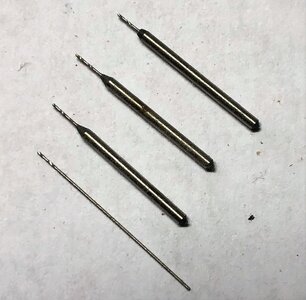The wood strips hold the brass strip from wandering laterally. I only drill through the brass and not through the aluminum. It give me a more solid under-surface than when I tried doing the drilling onto wood which caused the bottom of the brass to protrude downwards around the circumference. I thought that aluminum would reduce or prevent that distortion of the exit hole. I was not successful in only holding down the strip ends as the middle portion moved laterally.
The three holes are spaced 3/16 inch apart. I check the alignment of the jig by touching down on one end on the centerline and then traversing the table to the other end to check until I have those aligned on the centerline. Not a machinist approach but like walking in a long range shot to the target.
Your suggestion of a top plate with three drill guide holes would more accurately position the final holes in the brass but still require my correctly placing the bit through them. If I find the number of X revolutions between holes I could do it that way but it would be slower and possibly less accurate as long as I don't distort the guide holes. Let me know of your reaction to this. thanks, RIch
The three holes are spaced 3/16 inch apart. I check the alignment of the jig by touching down on one end on the centerline and then traversing the table to the other end to check until I have those aligned on the centerline. Not a machinist approach but like walking in a long range shot to the target.
Your suggestion of a top plate with three drill guide holes would more accurately position the final holes in the brass but still require my correctly placing the bit through them. If I find the number of X revolutions between holes I could do it that way but it would be slower and possibly less accurate as long as I don't distort the guide holes. Let me know of your reaction to this. thanks, RIch
Hi Rich,
Do you intend to drill down through the aluminium using the aluminum as your drill guide?
It is important that your jig and therefore the workpiece is parallel to the table, that is to say that the groove used to locate your brass strip is parallel to the table.
I would trim off the wood on either side of the aluminium as from what I can see it is not necessary or straight this may aid setting up.
Are the centre distances between holes similar?
Cheers,
Stephen.








